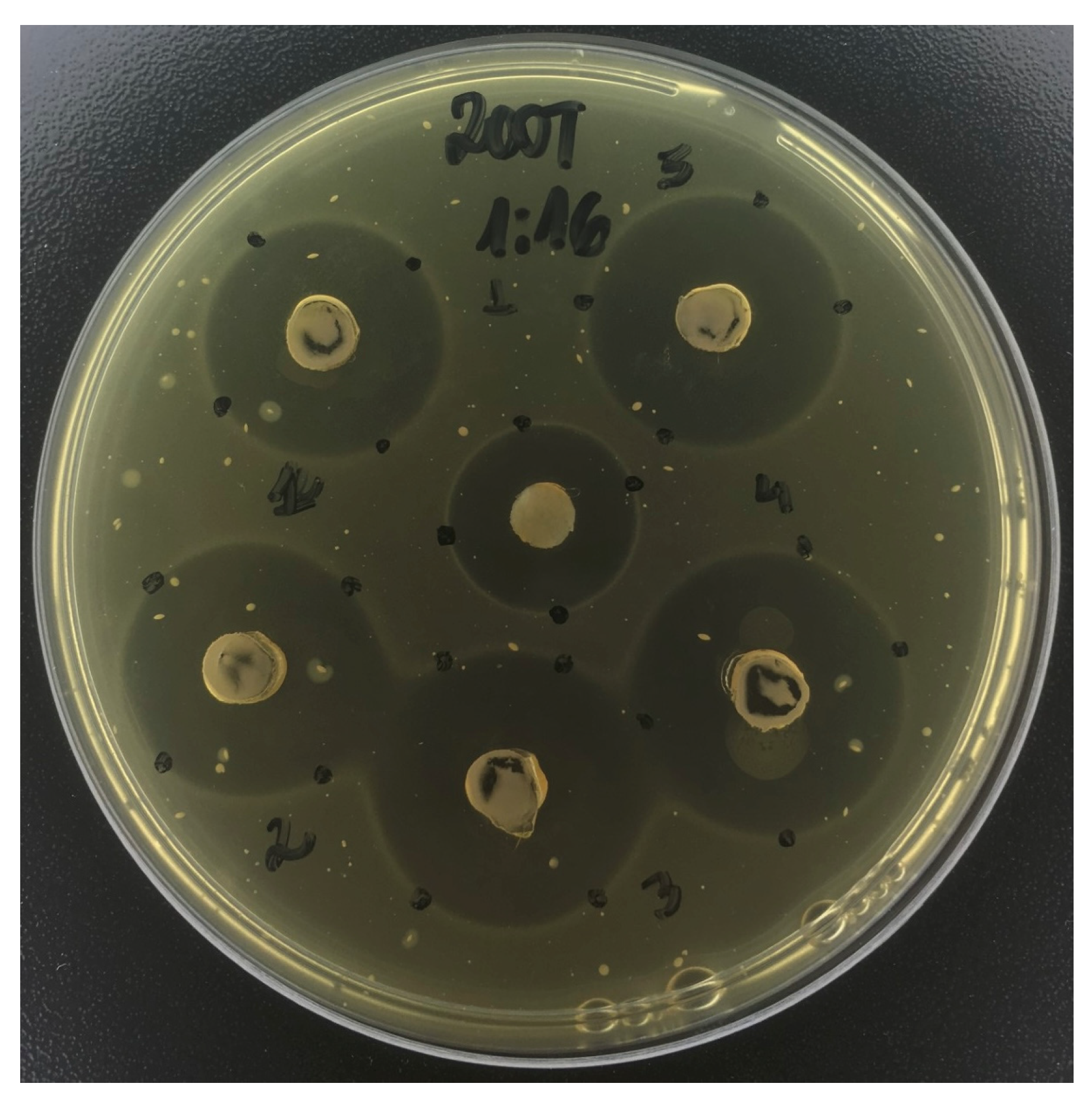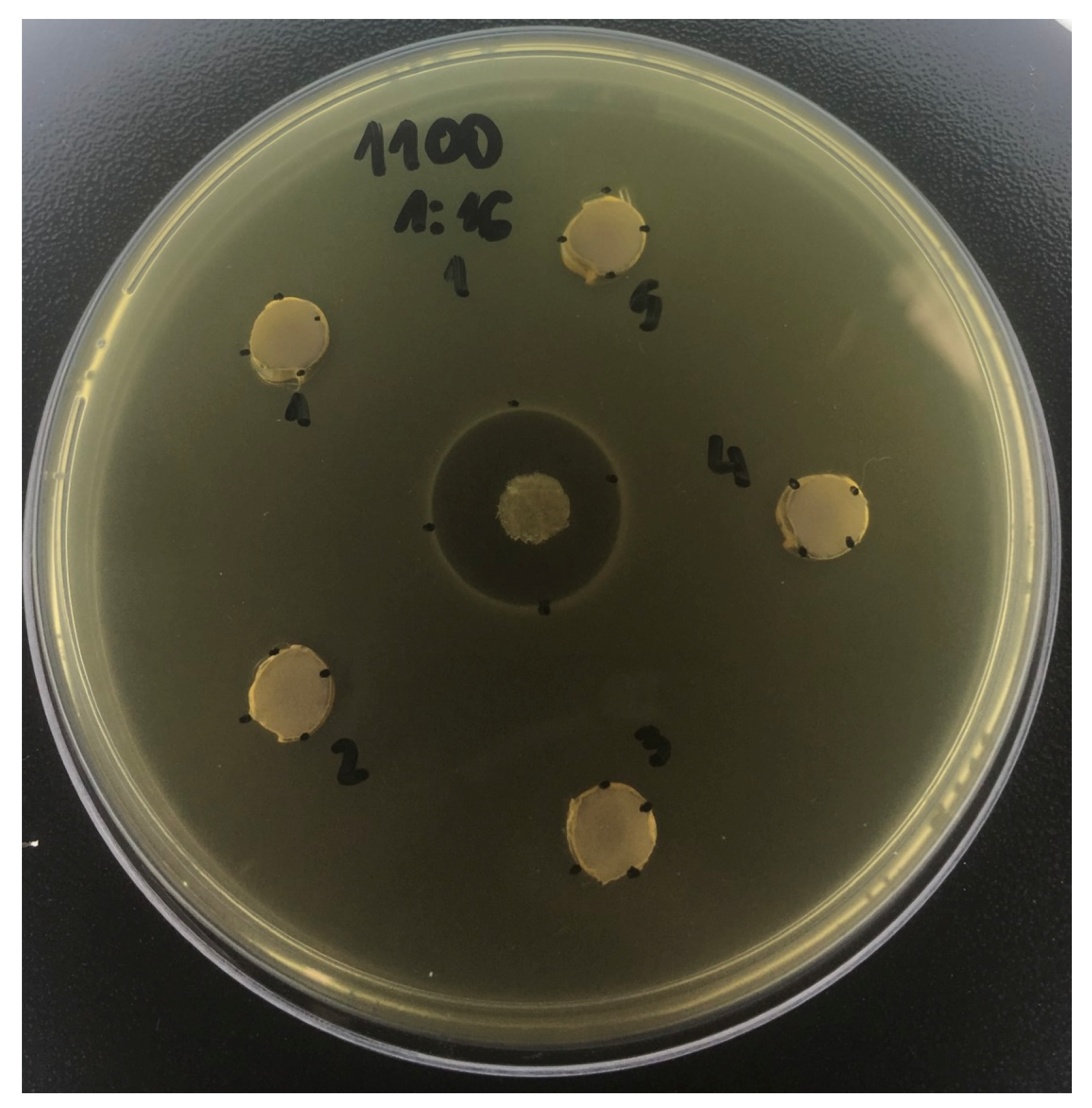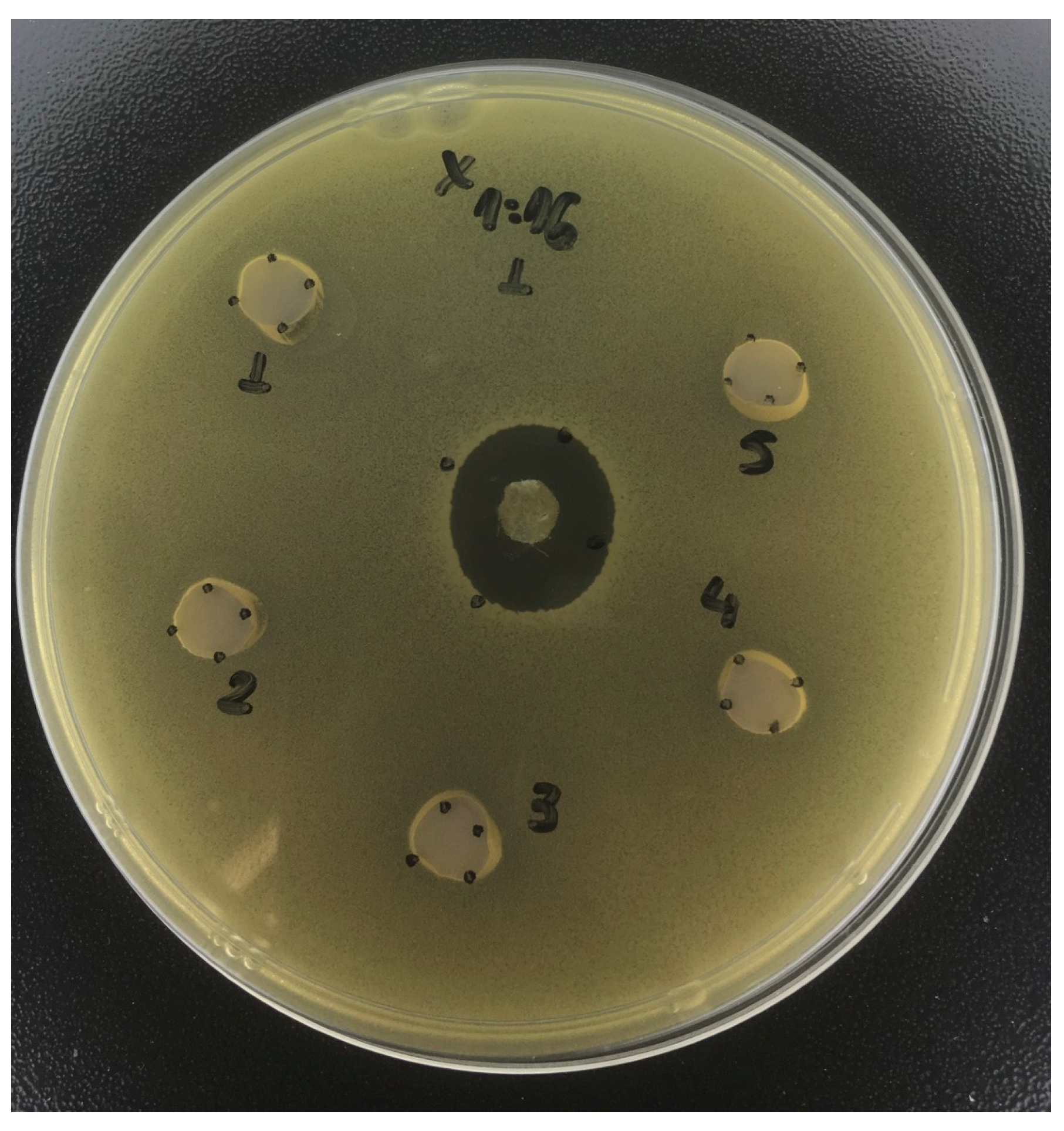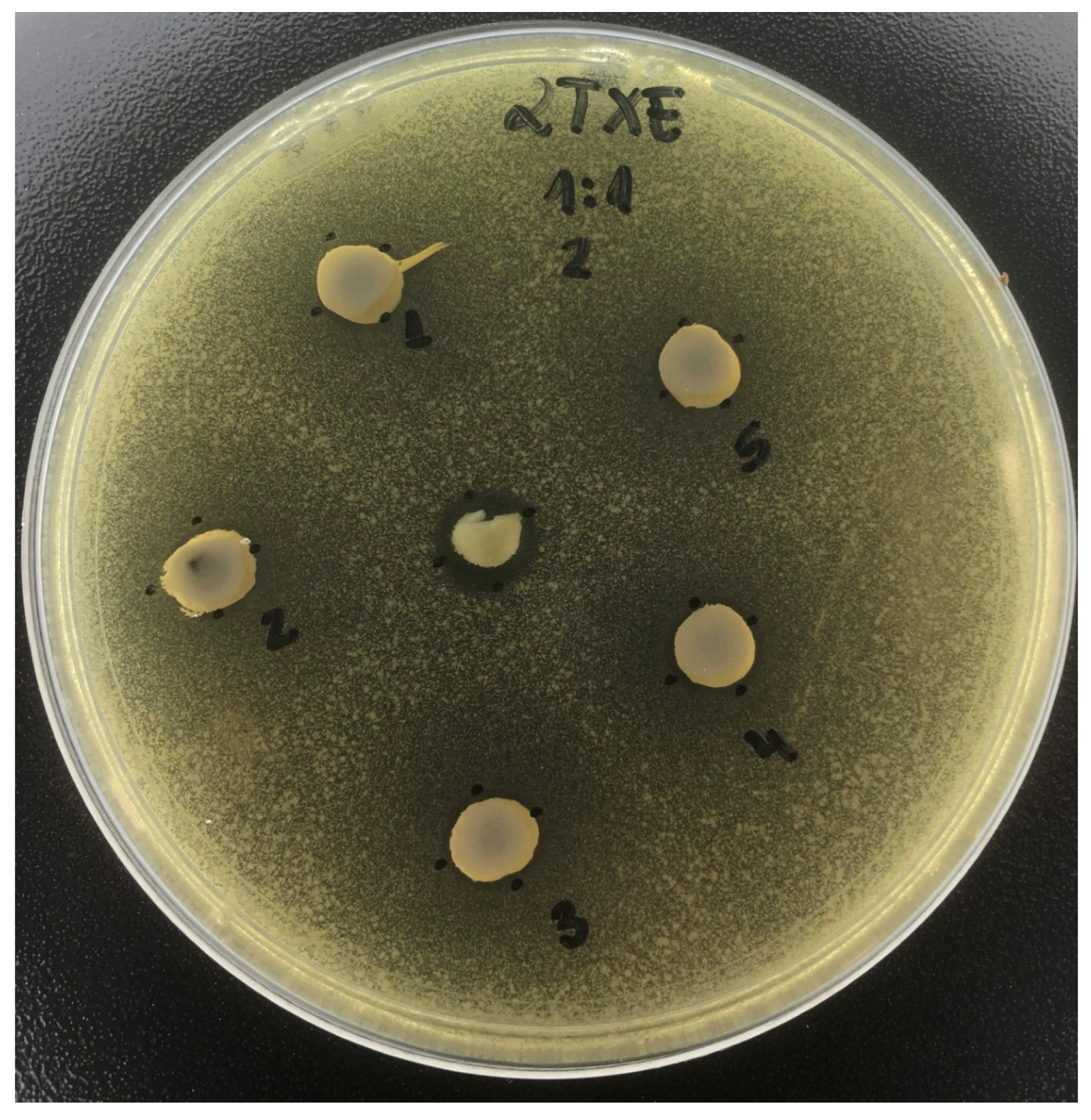Antimicrobial Effect of Low-Fluoride Toothpastes Containing Polyphosphate and Polyols: An In Vitro Assessment of Inhibition Zones
Abstract
1. Introduction
2. Results
3. Discussion




4. Materials and Methods
4.1. Preparation of Toothpaste Slurries
4.2. Antimicrobial Assay
4.3. Statistical Analysis
5. Conclusions
Author Contributions
Funding
Institutional Review Board Statement
Informed Consent Statement
Data Availability Statement
Conflicts of Interest
References
- Kassebaum, N.J.; Smith, A.G.C.; Bernabé, E.; Fleming, T.D.; Reynolds, A.E.; Vos, T.; Murray, C.J.L.; Marcenes, W.; GBD 2015 Oral Health Collaborators. Global, Regional, and National Prevalence, Incidence, and Disability-Adjusted Life Years for Oral Conditions for 195 Countries, 1990–2015: A Systematic Analysis for the Global Burden of Diseases, Injuries, and Risk Factors. J. Dent. Res. 2017, 96, 380–387. [Google Scholar] [CrossRef] [PubMed]
- Machiulskiene, V.; Campus, G.; Carvalho, J.C.; Dige, I.; Ekstrand, K.R.; Jablonski-Momeni, A.; Maltz, M.; Manton, D.J.; Martignon, S.; Martinez-Mier, E.A.; et al. Terminology of Dental Caries and Dental Caries Management: Consensus Report of a Workshop Organized by ORCA and Cariology Research Group of IADR. Caries Res. 2020, 54, 7–14. [Google Scholar] [CrossRef]
- Klein, M.I.; Hwang, G.; Santos, P.H.S.; Campanella, O.H.; Koo, H. Streptococcus mutans-derived extracellular matrix in cariogenic oral biofilms. Front. Cell. Infect. Microbiol. 2015, 5, 10. [Google Scholar] [CrossRef]
- Ribeiro, A.A.; Paster, B.J. Dental caries and their microbiomes in children: What do we do now? J. Oral Microbiol. 2023, 10, 2198433. [Google Scholar] [CrossRef]
- Falsetta, M.L.; Klein, M.I.; Colonne, P.M.; Scott-Anne, K.; Gregoire, S.; Pai, C.H.; Gonzalez-Begne, M.; Watson, G.; Krysan, D.J.; Bowen, W.H.; et al. Symbiotic relationship between Streptococcus mutans and Candida albicans synergizes virulence of plaque biofilms in vivo. Infect. Immun. 2014, 82, 1968–1981. [Google Scholar] [CrossRef]
- Menon, L.U.; Scoffield, J.A.; Jackson, J.G.; Zhang, P. Candida albicans and Early Childhood Caries. Front. Dent. Med. 2022, 3, 849274. [Google Scholar] [CrossRef]
- Sampaio, C.; Delbem, A.C.B.; Paiva, M.F.; Zen, I.; Danelon, M.; Cunha, R.F.; Pessan, J.P. Amount of Dentifrice and Fluoride Concentration Influence Salivary Fluoride Concentrations and Fluoride Intake by Toddlers. Caries Res. 2020, 54, 234–241. [Google Scholar] [CrossRef] [PubMed]
- Valkenburg, C.; Else Slot, D.; Van der Weijden, G.A. What is the effect of active ingredients in dentifrice on inhibiting the regrowth of overnight plaque? A systematic review. Int. J. Dent. Hyg. 2020, 18, 128–141. [Google Scholar] [CrossRef] [PubMed]
- Walsh, T.; Worthington, H.V.; Glenny, A.M.; Marinho, V.C.C.; Jeroncic, A. Fluoride toothpastes of different concentrations for preventing dental caries. Cochrane Database Syst. Rev. 2019, 3, CD007868. [Google Scholar] [CrossRef]
- Takeshita, E.M.; Danelon, M.; Castro, L.P.; Sassaki, K.T.; Delbem, A.C.B. Effectiveness of a toothpaste with low fluoride content combined with trimetaphosphate on dental biofilm and enamel demineralization in situ. Caries Res. 2015, 49, 394–400. [Google Scholar] [CrossRef] [PubMed]
- Takeshita, E.M.; Danelon, M.; Castro, L.P.; Cunha, R.F.; Delbem, A.C.B. Remineralizing Potential of a Low Fluoride Toothpaste with Sodium Trimetaphosphate: An in situ study. Caries Res. 2016, 50, 571–578. [Google Scholar] [CrossRef]
- Amaral, J.G.; Pessan, J.P.; Souza, J.A.S.; Moraes, J.C.S.; Delbem, A.C.B. Cyclotriphosphate associated to fluoride increases hydroxyapatite resistance to acid attack. J. Biomed. Mater. Res.-Part B Appl. Biomater. 2018, 106, 2553–2564. [Google Scholar] [CrossRef]
- Cavazana, T.P.; Hosida, T.Y.; Pessan, J.P.; Sampaio, C.; Monteiro, D.R.; Delbem, A.C.B. Activity of sodium trimetaphosphate, associated or not with fluoride, on dual-species biofilms. Biofouling 2019, 35, 710–718. [Google Scholar] [CrossRef] [PubMed]
- Lee, R.M.; Hartman, P.A.; Olson, D.G.; Williams, F.D. Bactericidal and bacteriolytic effects of selected food-grade phosphates, using Staphylococcus aureus as a model system. J. Food Prot. 1994, 57, 276–283. [Google Scholar] [CrossRef] [PubMed]
- Klompmaker, S.H.; Kohl, K.; Fasel, N.; Mayer, A. Magnesium uptake by connecting fluid-phase endocytosis to an intracellular inorganic cation filter. Nat. Commun. 2017, 8, 1879. [Google Scholar] [CrossRef]
- Söderling, E.; Pienihäkkinen, K. Effects of xylitol chewing gum and candies on the accumulation of dental plaque: A systematic review. Clin. Oral Investig. 2022, 26, 119–129. [Google Scholar] [CrossRef] [PubMed]
- Maehara, H.; Iwami, Y.; Mayanagi, H.; Takahashi, N. Synergistic inhibition by combination of fluoride and xylitol on glycolysis by mutans streptococci and its biochemical mechanism. Caries Res. 2005, 39, 521–528. [Google Scholar] [CrossRef]
- De Cock, P.; Mäkinen, K.; Honkala, E.; Saag, M.; Kennepohl, E.; Eapen, A. Erythritol Is More Effective Than Xylitol and Sorbitol in Managing Oral Health Endpoints. Int. J. Dent. 2016, 2016, 9868421. [Google Scholar] [CrossRef]
- Janus, M.M.; Volgenant, C.M.C.; Brandt, B.W.; Buijs, M.J.; Keijser, B.J.F.; Crielaard, W.; Zaura, E.; Krom, B.P. Effect of erythritol on microbial ecology of in vitro gingivitis biofilms. J. Oral Microbiol. 2017, 9, 1337477. [Google Scholar] [CrossRef]
- Mazur, M.; Ndokaj, A.; Bietolini, S.; Nisii, V.; Duś-Ilnicka, I.; Ottolenghi, L. Green dentistry: Organic toothpaste formulations. A literature review. Dent. Med. Probl. 2022, 59, 461–474. [Google Scholar] [CrossRef]
- Tanzer, J.M.; Livingston, J.; Thompson, A.M. The Microbiology of Primary Dental Caries in Humans. J. Dent. Educ. 2001, 65, 1028–1037. [Google Scholar] [CrossRef] [PubMed]
- Trahan, L. Xylitol: A review of its action on mutans streptococci and dental plaque--its clinical significance. Int. Dent. J. 1995, 45, 77–92. [Google Scholar]
- Cavazana, T.P.; Pessan, J.P.; Hosida, T.Y.; Sampaio, C.; Amarante, V.O.Z.; Monteiro, D.R.; Delbem, A.C.B. Effects of Sodium Trimetaphosphate, Associated or Not with Fluoride, on the Composition and pH of Mixed Biofilms, before and after Exposure to Sucrose. Caries Res. 2020, 54, 358–368. [Google Scholar] [CrossRef] [PubMed]
- Söderling, E.M.; Hietala-Lenkkeri, A.M. Xylitol and erythritol decrease adherence of polysaccharide-producing oral streptococci. Curr. Microbiol. 2010, 60, 25–29. [Google Scholar] [CrossRef]
- Loimaranta, V.; Mazurel, D.; Deng, D.; Söderling, E. Xylitol and erythritol inhibit real-time biofilm formation of Streptococcus mutans. BMC Microbiol. 2020, 29, 184. [Google Scholar] [CrossRef] [PubMed]
- Nardi, G.M.; Fais, S.; Casu, C.; Mazur, M.; Di Giorgio, R.; Grassi, R.; Grassi, F.R.; Orrù, G. Mouthwash Based on Ozonated Olive Oil in Caries Prevention: A Preliminary In-Vitro Study. Int. J. Environ. Res. Public Health 2020, 17, 9106. [Google Scholar] [CrossRef]
- Mäkinen, K.; Alanen, P.; Isokangas, P.; Isotupa, K.; Söderling, E.; Mäkinen, P.L.; Wenhui, W.; Weijian, W.; Chen, X.; Wei, Y.; et al. Thirty-nine-month xylitol chewing-gum programme in initially 8-year-old school children: A feasibility study focusing on mutans streptococci and lactobacilli. Int. Dent. J. 2008, 58, 41–50. [Google Scholar] [CrossRef]
- Mäkinen, K.; Chen, C.; Mäkinen, P.; Bennett, C.; Isokangas, P.; Isotupa, K.; Pape, H. Properties of whole saliva and dental plaque in relation to 40-month consumption of chewing gums containing xylitol, sorbitol or sucrose. Caries Res. 1996, 30, 180–188. [Google Scholar] [CrossRef]
- Mäkinen, K.K.; Bennett, C.A.; Hujoel, P.P.; Isokangas, P.J.; Isotupa, K.P.; Pape, H.R., Jr.; Makinen, P.L. Xylitol chewing gums and caries rates: A 40-month cohort study. J. Dent. Res. 1995, 74, 1904–1913. [Google Scholar] [CrossRef]
- Söderling, E.; Hirvonen, A.; Karjalainen, S.; Fontana, M.; Catt, D.; Seppä, L. The Effect of xylitol on the composition of the oral flora: A pilot study. Eur. J. Dent. 2011, 5, 24–31. [Google Scholar] [CrossRef] [PubMed]
- Maden, E.; Altun, C.; Ozmen, B.; Basak, F. Antimicrobial Effect of Toothpastes Containing Fluoride, Xylitol, or Xylitol-Probiotic on Salivary Streptococcus mutans and Lactobacillus in Children. Niger. J. Clin. Pract. 2018, 21, 134–138. [Google Scholar] [PubMed]
- Hausman, S.; Thompson, J.; London, J. Futile Xylitol Cycle in Lactobacillus casei. J. Bacteriol. 1984, 160, 211–215. [Google Scholar] [CrossRef] [PubMed]
- Helanto, M.; Aarnikunnas, J.; Palva, A.; Leisola, M.; Nyyssölä, A. Characterization of genes involved in fructose utilization by Lactobacillus fermentum. Arch. Microbiol. 2006, 186, 51–59. [Google Scholar] [CrossRef]
- London, J.; Hausman, S. Xylitol-Mediated Transient Inhibition of Ribitol Utilization by Lactobacillus casei. J. Bacteriol. 1982, 150, 657–661. [Google Scholar] [CrossRef] [PubMed]
- Radmerikhi, S.; Azul, E.; Fajardo, K.R.; Formantes, B. Antimicrobial effect of different xylitol concentrations on Streptococcus mutans and Lactobacillus acidophilus count. J. Restor. Dent. 2013, 1, 95. [Google Scholar] [CrossRef]
- Vadeboncoeur, C.; Trahan, L.; Mouton, C.; Mayrand, D. Effect of xylitol on the growth and glycolysis of acidogenic oral bacteria. J. Dent. Res. 1983, 62, 882–884. [Google Scholar] [CrossRef]
- Yadav, K.; Prakash, S. Dental Caries: A Microbiological Approach. J. Clin. Infect. Dis. Pract. 2017, 2, 118. [Google Scholar] [CrossRef]
- Talattof, Z.; Azad, A.; Zahed, M.; Shahradnia, N. Antifungal activity of Xylitol against Candida albicans: An in vitro study. J. Contemp. Dent. Pract. 2018, 19, 125–129. [Google Scholar] [CrossRef]
- Ameglio, F.; Di Giorgio, C.; Terzaroli, P.; Gandolfo, G.M. “Giant cell” production by C. albicans cultured in xylitol. Microbiologica 1990, 13, 343–346. [Google Scholar]
- Leepel, L.; Sastra, S.; Puspitawati, R.; Bachtiar, B. Effect of Xylitol with Various Concentration and Duration on the Growth of Candida albicans (In Vitro study). J. Dent. Indones. 2012, 16, 72–76. [Google Scholar] [CrossRef][Green Version]
- Ichikawa, T.; Yano, Y.; Fujita, Y.; Kashiwabara, T.; Nagao, K. The enhancement effect of three sugar alcohols on the fungicidal effect of benzethonium chloride toward Candida albicans. J. Dent. 2008, 36, 965–968. [Google Scholar] [CrossRef] [PubMed]
- Koo, H.; Sheng, J.; Nguyen, P.T.M.; Marquis, R.E. Co-operative inhibition by fluoride and zinc of glucosyl transferase production and polysaccharide synthesis by mutans streptococci in suspension cultures and biofilms. FEMS Microbiol. Lett. 2006, 254, 134–140. [Google Scholar] [CrossRef] [PubMed]
- Pandit, S.; Kim, J.E.; Jung, K.H.; Chang, K.W.; Jeon, J.G. Effect of sodium fluoride on the virulence factors and composition of Streptococcus mutans biofilms. Arch. Oral Biol. 2011, 56, 643–649. [Google Scholar] [CrossRef] [PubMed]
- Girão Júnior, F.J.; Valadas, L.A.R.; Bottenberg, P.; Lotif, M.A.L.; Rodrigues Neto, E.M.; Fonseca, S.G.D.C.; Bandeira, M.A.M.; Squassi, A.; Dantas, T.C.F.B.; de Sena, N.J.C.; et al. Salivary Fluoride Bioavailability after Brushing with Brazilian Red Propolis Dentifrice: A Clinical Study. Evid. Based. Complement. Alternat. Med. 2022, 31, 6148137. [Google Scholar] [CrossRef]
- Philip, N.; Leishman, S.J.; Bandara, H.M.H.N.; Healey, D.L.; Walsh, L.J. Randomized Controlled Study to Evaluate Microbial Ecological Effects of CPP-ACP and Cranberry on Dental Plaque. JDR Clin. Trans. Res. 2020, 5, 118–126. [Google Scholar] [CrossRef] [PubMed]
- Malhotra, R.; Shashikiran, N. Comparison of Antimicrobial Activity of Child Formula Dentifrices at different Concentrations: An in vitro Study. Int. J. Clin. Pediatr. Dent. 2017, 10, 131–135. [Google Scholar] [CrossRef] [PubMed]
| Toothpaste Dilutions (in Deionized Water) | |||||
|---|---|---|---|---|---|
| Groups | D1 | D2 | D4 | D8 | D16 |
| PLA | 12.7 ± 0.3 Aa (11.8–13.6) | 10.4 ± 0.4 Bab (9.4–11.5) | 10.5 ± 0.8 Ba (8.7–12.4) | 10.5 ± 0.5 Bab (9.3–11.6) | 10.3 ± 0.5 Bab (9.1–11.6) |
| X | 10.8 ± 0.6 Ab (9.2–12.3) | 10.4 ± 0.5 Aab (9.0–11.7) | 10.2 ± 0.4 Aa (9.2–11.2) | 10.1 ± 0.3 Ab (9.4–10.8) | 10.0 ± 0.3 Aab (9.5–10.7) |
| E | 10.2 ± 0.2 Ab (9.8–10.6) | 10.5 ± 0.5 Aab (9.2–11.6) | 10.3 ± 0.4 Aa (9.1–11.4) | 10.5 ± 0.5 Aab (9.4–11.5) | 9.8 ± 0.2 Ab (9.3–10.1) |
| TMP | 10.8 ± 0.2 Ab (10.3–11.1) | 10.5 ± 0.5 Bab (9.3–11.7) | 10.3 ± 0.4 Ba (8.6–11.9) | 10.6 ± 0.4 Bab (9.4–11.7) | 10.4 ± 0.3 Bab (9.4–11.0) |
| 200F | 10.2 ± 0.6 Ab (12.2–11.5) | 12.2 ± 0.6 Bb (11.5–12.6) | 11.7 ± 0.1 BCb (11.7–11.8) | 11.7 ± 0.4 BCc (11.6–12.0) | 11.9 ± 0.4 Cc (11.8–14.1) |
| 1100F | 11.1 ± 0.4 Ab (10.0–11.9) | 11.2 ± 0.2 Aab (10.6–11.5) | 11.1 ± 0.4 Aa (10.8–11.4) | 11.6 ± 0.3 Aac (11.4–11.7) | 11.3 ± 0.3 Aa (10.7–11.9) |
| X+E | 11.4 ± 0.8 Aab (9.3–13.3) | 10.2 ± 0.5 Aa (8.9–11.4) | 11 ± 0.5 Aa (9.9–12.0) | 10.5 ± 0.5 Aab (9.4–11.5) | 10.2 ± 0.2 Aab (9.7–10.5) |
| 200F+TMP | 21.1 ± 0.2 Ac (20.9–21.2) | 20.3 ± 0.4 Bc (19.2–21.5) | 19.9 ± 0.3 Bc (19.7–20.0) | 19.5 ± 0.5 Bd (19.4–19.9) | 19.2 ± 0.2 Bd (19.1–19.4) |
| 200F+X+E | 11.4 ± 0.4 Aab (10.3–12.4) | 11.4 ± 0.3 Ab (11.2–12.6) | 11.3 ± 0.4 Cb (11.1–11.5) | 11.3 ± 0.3 Cc (11.0–11.4) | 11.2 ± 0.3 Cc (11.1–11.3) |
| TMP+X+E | 11.1 ± 0.6 Ab (9.5–12.6) | 11.0 ± 0.5 Aab (9.8–12.1) | 10.7 ± 0.5 Aa (9.5–11.8) | 10.6 ± 0.5 Aab (9.4–11.7) | 10.4 ± 0.6 Aab (8.8–12.0) |
| EXP | 10.7 ± 0.4 Ab (9.3–12.0) | 10.2 ± 0.2 Aa (9.3–11.0) | 10.2 ± 0.6 Aa (9.9–11.1) | 10.1 ± 0.4 Aab (10.0–10.4) | 10.0 ± 0.5 Ab (10.0–10.5) |
| Toothpaste Dilutions (in Deionized Water) | |||||
|---|---|---|---|---|---|
| Groups | D1 | D2 | D4 | D8 | D16 |
| PLA | 13.4 ± 0.3 Aab (12.6–14.2) | 12.0 ± 0.1 Ba (11.8–12.1) | 12.0 ± 0.4 Bab (10.8–13.4) | 11.2 ± 0.2 Bab (10.5–11.8) | 6.5 ± 0.4 Ca (5.4–7.4) |
| X | 15.4 ± 0.2 Ad (14.7–16.0) | 12.9 ± 0.1 Bab (12.6–13.1) | 12.0 ± 0.4 Babc (11.1–13.0) | 11.9 ± 0.2 Bb (11.5–12.1) | 6.5 ± 0.2 Ca (5.9–7.1) |
| E | 13.1 ± 0.3 Aab (12.9–13.2) | 13.4 ± 0.4 Ab (13.4–13.8) | 11.4 ± 0.4 Ba (10.2–12.5) | 11.6 ± 0.3 Bab (11.4–11.7) | 11.8 ± 0.3 Bb (11.5–11.8) |
| TMP | 12.8 ± 0.3 Abc (12.6–12.9) | 12.6 ± 0.1 ABab (12.4–12.7) | 13.2 ± 0.2 Ac (13.0–13.3) | 11.5 ± 0.9 Bab (9.2–13.6) | 6.5 ± 0.3 Ca (5.8–7.1) |
| 200F | 12.0 ± 0.1 Ac (11.5–12.3) | 12.3 ± 0.5 Aab (11.1–13.5) | 11.5 ± 0.5 Aa (11.0–11.6) | 6.7 ± 0.2 Bc (6.2–7.1) | 6.8 ± 0.2 Ba (6.3–7.1) |
| 1100F | 13.9 ± 0.2 Aa (13.4–14.4) | 12.9 ± 0.2 ABab (12.7–13.0) | 11.9 ± 0.6 Ba (11.0–12.7) | 10.7 ± 0.8 Ca (8.8–12.6) | 6.8 ± 0.2 Da (6.6–6.9) |
| X+E | 13.2 ± 0.1 Aab (13.0–13.3) | 13.2 ± 0.1 Ab (13.0–13.3) | 11.9 ± 0.1 Ba (11.6–12.2) | 10.8 ± 0.2 Bab (10.2–11.4) | 6.1 ± 0.7 Ca (4.4–7.7) |
| 200F+TMP | 11.9 ± 0.1 Ac (11.8–12.1) | 12.1 ± 0.2 Aa (11.9–12.2) | 11.9 ± 0.3 Aa (11.0–12.6) | 11.0 ± 0.2 ABab (10.8–11.1) | 9.9 ± 0.2 Bc (9.7–10.0) |
| 200F+X+E | 13.9 ± 0.2 Aab (13.4–14.4) | 13.4 ± 0.4 Bc (13.1–13.6) | 13.3 ± 0.4 Ac (13.2–13.5) | 11.5 ± 0.1 Cab (11.3–11.6) | 6.2 ± 0.3 Da (5.2–7.1) |
| TMP+X+E | 13.1 ± 0.2 Aab (12.9–13.2) | 14.8 ± 0.3 Bd (14.5–14.8) | 12.4 ± 0.9 Aabc (10.2–14.5) | 12.2 ± 1.0 Bd (12.6–17.7) | 6.5 ± 0.3 Ca (5.9–7.1) |
| EXP | 14.2 ± 0.2 Ad (14.0–14.4) | 13.5 ± 0.3 Bab (13.1–13.9) | 13.1 ± 0.3 Bbc (13.0–13.2) | 11.0 ± 0.2 Cab (10.8–11.1) | 9.3 ± 0.4 Dc (9.1–9.5) |
| Toothpaste Dilutions (in Deionized Water) | |||||
|---|---|---|---|---|---|
| Groups | D1 | D2 | D4 | D8 | D16 |
| PLA | 5.9 ± 0.1 Aa (5.8–6.1) | 5.6 ± 0.2 Aa (5.3–6.0) | 5.8 ± 0.3 Aa (5.2–6.5) | 6.1 ± 0.2 Aa (5.6–6.4) | 6.1 ± 0.1 Aa (5.8–6.4) |
| X | 5.9 ± 0.2 Aa (5.5–6.3) | 5.9 ± 0.1 Aa (5.7–6.1) | 6.1 ± 0.2 Aa (5.7–6.5) | 5.9 ± 0.1 Aa (5.6–6.2) | 6.0 ± 0.3 Aab (5.1–6.9) |
| E | 6.2 ± 0.1 Aa (6.2–6.2) | 6.1 ± 0.2 Aa (5.7–6.4) | 6.0 ± 0.2 Aa (5.7–6.4) | 5.9 ± 0.1 Aa (5.6–6.2) | 6.0 ± 0.1 Aab (5.5–6.3) |
| TMP | 5.9 ± 0.2 Aa (5.8–6.3) | 6.0 ± 0.4 Aa (5.6–6.4) | 5.9 ± 0.3 Aa (5.7–6.0) | 6.0 ± 0.2 Aa (5.4–6.6) | 5.9 ± 0.3 Aab (5.6–6.1) |
| 200F | 6.2 ± 0.1 Aa (6.0–6.3) | 5.8 ± 0.1 Aa (5.7–6.0) | 5.7 ± 0.1 Aa (5.2–6.1) | 6.7 ± 0.2 Bb (6.2–7.1) | 6.7 ± 0.4 Bc (6.2–6.9) |
| 1100F | 5.7 ± 0.3 Aa (5.5–6.0) | 6.0 ± 0.3 Aa (5.8–6.3) | 5.8 ± 0.2 Aa (5.4–6.2) | 5.9 ± 0.2 Aa (5.3–6.6) | 6.0 ± 0.2 Aab (6.0–6.2) |
| X+E | 6.0 ± 0.1 Aa (5.8–6.1) | 5.7 ± 0.2 Aa (5.2–6.2) | 5.8 ± 0.4 Aa (5.6–6.1) | 5.7 ± 0.3 Aa (5.4–6.0) | 5.9 ± 0.2 Aab (5.5–6.4) |
| 200F+TMP | 5.7 ± 0.2 Aa (5.2–6.3) | 5.7 ± 0.2 Aa (5.2–6.2) | 5.6 ± 0.2 Aa (5.2–6.1) | 5.8 ± 0.3 Aa (5.3–6.3) | 5.5 ± 0.4 Ab (5.1–6.0) |
| 200F+X+E | 5.7 ± 0.2 Aa (5.3–6.2) | 5.8 ± 0.3 Aa (5.0–6.6) | 5.7 ± 0.3 Aa (5.5–6.0) | 5.9 ± 0.1 Aa (5.7–6.0) | 5.1 ± 0.2 Aab (5.6–6.1) |
| TMP+X+E | 6.0 ± 0.2 Aa (5.8–6.1) | 5.9 ± 0.1 Aa (5.7–6.2) | 5.8 ± 0.3 Aa (5.6–6.0) | 5.9 ± 0.3 Aa (5.7–6.0) | 5.9 ± 0.3 Aab (5.7–6.0) |
| EXP | 5.8 ± 0.1 Aa (5.6–5.9) | 6.0 ± 0.3 Aa (5.6–6.4) | 5.9 ± 0.1 Aa (5.8–6.1) | 5.9 ± 0.3 Aa (5.5–6.3) | 6.1 ± 0.3 Aa (5.8–6.4) |
| Toothpaste Dilutions (in Deionized Water) | |||||
|---|---|---|---|---|---|
| Groups | D1 | D2 | D4 | D8 | D16 |
| PLA | 5.6 ± 0.2 Aa (4.9–6.4) | 5.5 ± 0.1 Aa (5.1–5.9) | 5.6 ± 0.3 Aa (5.3–5.8) | 5.8 ± 0.7 Aa (5.7–6.0) | 5.6 ± 0.3 Aab (5.5–5.8) |
| X | 5.7 ± 0.1 Aa (5.6–5.9) | 5.7 ± 0.3 Aa (5.3–6.2) | 5.7 ± 0.3 Aa (4.9–6.4) | 5.9 ± 0.5 Aa (5.7–6.8) | 5.4 ± 0.4 Aa (5.2–5.5) |
| E | 5.9 ± 0.3 Aa (5.2–6.5) | 5.8 ± 0.3 Aa (5.4–6.2) | 5.9 ± 0.5 Aab (5.2–6.7) | 5.8 ± 0.3 Aa (5.0–6.6) | 5.9 ± 0.3 Aab (5.2–6.7) |
| TMP | 6.2 ± 0.2 Aab (5.5–6.9) | 5.1 ± 0.1 ABa (5.1–6.0) | 5.1 ± 0.2 ABab (5.0–6.1) | 5.4 ± 0.2 Ba (5.2–6.5) | 5.7 ± 0.5 ABab (5.3–6.1) |
| 200F | 5.8 ± 0.1 Aa (5.5–6.1) | 5.5 ± 0.1 Aa (5.1–5.9) | 5.6 ± 0.9 Aa (5.3–5.9) | 5.8 ± 0.1 Aa (5.4–6.2) | 5.6 ± 0.7 Aab (5.4–5.7) |
| 1100F | 6.1 ± 0.2 Aab (5.5–6.7) | 5.9 ± 0.2 Aab (5.7–6.2) | 6.1 ± 0.3 Aab (5.4–6.8) | 5.8 ± 0.2 Aa (5.4–6.3) | 5.8 ± 0.1 Aab (5.5–6.0) |
| X+E | 6.0 ± 0.5 Aab (5.8–6.3) | 5.1 ± 0.3 Aa (5.1–6.0) | 5.1 ± 0.2 Aa (5.1–5.4) | 5.1 ± 0.3 Aa (5.0–5.7) | 5.0 ± 0.9 Aab (5.0–5.4) |
| 200F+TMP | 5.8 ± 0.1 Aa (5.5–6.1) | 5.5 ± 0.4 Aa (5.1–5.9) | 5.6 ± 0.2 Aa (5.3–5.9) | 5.8 ± 0.1 Aa (5.4–6.2) | 5.6 ± 0.7 Aab (5.4–5.7) |
| 200F+X+E | 6.6 ± 0.1 ABb (6.4–6.7) | 6.6 ± 0.2 Bb (6.3–6.9) | 5.9 ± 0.4 ACab (5.6–6.2) | 5.7 ± 0.3 Ca (5.3–6.1) | 5.9 ± 0.2 ACab (5.3–6.5) |
| TMP+X+E | 5.7 ± 0.2 Aa (5.4–5.9) | 5.7 ± 0.2 Aa (5.2–6.2) | 5.8 ± 0.2 Aa (5.5–6.0) | 5.8 ± 0.1 Aa (5.5–6.5) | 5.7 ± 0.7 Aab (5.2–6.2) |
| EXP | 7.9 ± 0.4 Ac (6.7–9.1) | 7.6 ± 0.3 Ac (6.6–8.5) | 6.6 ± 0.2 Bb (6.1–7.1) | 6.0 ± 0.7 Ba (5.4–6.7) | 6.0 ± 0.1 Bb (5.9–6.5) |
Disclaimer/Publisher’s Note: The statements, opinions and data contained in all publications are solely those of the individual author(s) and contributor(s) and not of MDPI and/or the editor(s). MDPI and/or the editor(s) disclaim responsibility for any injury to people or property resulting from any ideas, methods, instructions or products referred to in the content. |
© 2023 by the authors. Licensee MDPI, Basel, Switzerland. This article is an open access article distributed under the terms and conditions of the Creative Commons Attribution (CC BY) license (https://creativecommons.org/licenses/by/4.0/).
Share and Cite
Zen, I.; Delbem, A.C.B.; Hosida, T.Y.; Sampaio, C.; de Morais, L.A.; Martins, T.P.; Monteiro, D.R.; Pessan, J.P. Antimicrobial Effect of Low-Fluoride Toothpastes Containing Polyphosphate and Polyols: An In Vitro Assessment of Inhibition Zones. Antibiotics 2023, 12, 1333. https://doi.org/10.3390/antibiotics12081333
Zen I, Delbem ACB, Hosida TY, Sampaio C, de Morais LA, Martins TP, Monteiro DR, Pessan JP. Antimicrobial Effect of Low-Fluoride Toothpastes Containing Polyphosphate and Polyols: An In Vitro Assessment of Inhibition Zones. Antibiotics. 2023; 12(8):1333. https://doi.org/10.3390/antibiotics12081333
Chicago/Turabian StyleZen, Igor, Alberto Carlos Botazzo Delbem, Thayse Yumi Hosida, Caio Sampaio, Leonardo Antônio de Morais, Tamires Passadori Martins, Douglas Roberto Monteiro, and Juliano Pelim Pessan. 2023. "Antimicrobial Effect of Low-Fluoride Toothpastes Containing Polyphosphate and Polyols: An In Vitro Assessment of Inhibition Zones" Antibiotics 12, no. 8: 1333. https://doi.org/10.3390/antibiotics12081333
APA StyleZen, I., Delbem, A. C. B., Hosida, T. Y., Sampaio, C., de Morais, L. A., Martins, T. P., Monteiro, D. R., & Pessan, J. P. (2023). Antimicrobial Effect of Low-Fluoride Toothpastes Containing Polyphosphate and Polyols: An In Vitro Assessment of Inhibition Zones. Antibiotics, 12(8), 1333. https://doi.org/10.3390/antibiotics12081333






